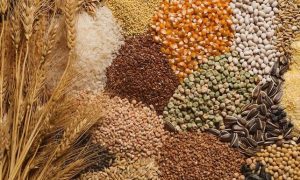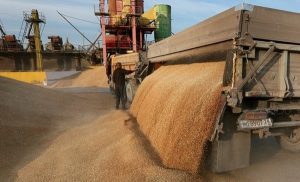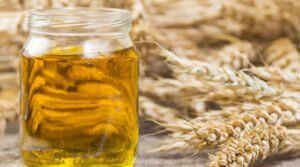
Since the beginning of the new 2020/2021 marketing year (MY, July-June) and as of December 4, Ukraine has exported 22.12 million tonnes of cereals and legumes, which is 3.4 million tonnes less than on the same date last MY.
According to the information and analytical portal of the agro-industrial complex of Ukraine, 12.02 million tonnes of wheat (-1.6 million tonnes), 3.71 million tonnes of barley (+0.2 million tonnes) and 6.03 million tonnes of corn (-2.1 million tonnes) have been exported to date.
As of December 4 of this year, 70,300 tonnes of flour were also exported.
As reported, Ukraine exported a record 57.2 million tonnes of grains, legumes and flour in 2019/2020 MY, which is 13.5% more than in the previous MY.

Ukraine since the beginning of the new 2020/2021 marketing year (MY, July-June) and as of October 2 had exported 12.15 million tonnes of grain and legumes, which is 1.61 million tonnes less (due to corn) than on this date in the past MY.
According to the information and analytical portal of the agro-industrial complex of Ukraine, to date, 8.56 million tonnes of wheat, 2.88 million tonnes of barley and 680,000 tonnes of corn (1.39 million tonnes less) have been exported.
As of October 2 of this year, 50,300 tonnes of flour were also exported.
As reported, Ukraine exported a record 57.2 million tonnes of grain, legumes and flour in the 2019/2020 MY, which is 13.5% more than in the previous MY.

Ukrainian exporters this year will use the opportunities for 31 out of 40 tariff quotas for duty-free supplies of agricultural products to the European Union, as of the end of August, eight tariff quotas have already been fully used, the Development Director of the Ukrainian Horticultural Association, UN FAO International Consultant Yekateryna Zvereva has said.
“In 2020, Ukrainian exporters will take advantage of 31 out of 40 tariff quotas. As of the end of August, eight tariff quotas have already been fully used: honey, barley and flour, processed tomatoes, processed starch, grape and apple juices, corn, malt and starch products, sugar. Tariff quotas are used for cereals (81.2%), eggs and albumin (75%), poultry (73.4%), starch (73.3%), malt and wheat gluten (72.2%), additional quotas for eggs and albumin (60.4%), bran, waste and residues (55.2%), additional quota for poultry (53.1%), oats (45.3%), wheat (40.2%), etc.,” she wrote in a column for the Interfax-Ukraine agency.
According to Zvereva, in 2016-2019 the positive dynamics of development of trade with the European Union, which today is the main trade partner of Ukraine with a share of more than 41% of the total volume of trade in goods, is obvious. Trade in goods with high added value is gradually growing.

Since the beginning of the new 2020/2021 agricultural year (July-June) and as of September 14, Ukraine exported 9.44 million tonnes of cereals and legumes, which is 1.68 million tonnes less (due to corn) than on this date last agri-year.
According to the information and analytical portal of the agro-industrial complex of Ukraine, to date, 6.33 million tonnes of wheat, 2.47 million tonnes of barley and 0.61 million tonnes of corn (1.28 million tonnes less) have been exported.
As of September 14 this year, 40,900 tonnes of flour were also exported.
As reported, in the 2019/2020 agri-year Ukraine exported a record of 57.2 million tonnes of grains, legumes and flour, which is 13.5% more than in the previous agri-year.

Ukrainian agricultural exports to the European Union (EU) countries in January-May 2019 grew by 30.8% compared with the same period in 2018, to $2.97 billion, Acting Minister of Agrarian Policy and Food of Ukraine Olha Trofimtseva has said. “Export of Ukrainian products to the EU during the reporting period increased 30.8%, to $2.967 billion. Import increased 12.1% and amounted to $1.227 billion,” she wrote on her Facebook page on Friday.
The share of the Netherlands of goods turnover between Ukraine and the EU countries was 17.6%, Spain’s – 13.7%, Poland – 13.1%, Germany – 10.8%, Italy – 10.8%, France – 5.7%, the U.K. – 4.1%, Belgium – 3.2%, Portugal – 2.9%, Hungary – 2.9% and Ireland – 2.7%.
The main products in the structure of exports to the EU are cereal grains – $1.4 billion, vegetable oils – $610.5 million, leftovers and waste from the food industry – $272.8 million, oilseeds – $177.4 million, meat and edible offal of poultry – nearly $86 million, fruits, nuts and zest – $53 million, grain products and cereals – $36.4 million, honey – $34.6 million.

Exports of Ukrainian agrarian products to European countries in January-February 2018 increased by 28.1%, or by $224.7 million, and amounted to $1.025 billion compared to the same period of 2017, the Ministry of Agrarian Policy and Food reported referring to the deputy minister for European integration, Olha Trofimtseva. “Thus, at the moment, the EU accounts for 36.5% of our agricultural exports,” she said.
On the whole, the foreign trade in agricultural products in the first two months of 2018 amounted to $3.7 billion, of which $2.8 billion fall for the export of Ukrainian agrarian and food products.
“In the first two months of this year, Ukrainian agrarian exports increased by $102.1 million compared to the corresponding period of 2017 and reached $2.8 billion. Our traditional export leaders are cereals with a 35.3% share, vegetable oil with 24.1% and oilseeds with 12%,” the deputy minister added. During this period, export of Ukrainian poultry meat grew by $29 million, eggs by $11.4 million, butter by $20 million, chocolate by $7.5 million, grape wines by $6.1 million, she said.
According to Trofimtseva, in January-February 2018, the largest importer of Ukrainian agrarian and food products was India, which imported Ukrainian products worth $335.9 million. The top five trade partners included Spain with $201.1 million worth of imported Ukrainian products, the Netherlands with $199.3 million, Egypt with $189.6 million and Italy with $185.6 million.
AGRARIAN, AGRI EXPORT, EU, IMPORT, INDIA